Patricia Esposito
Genre: Sculpture
Media: metal, wood, photographs, electrical lighting, found objects
Website: http://www.patriciaespositoart.com.
Summary:
Patricia Esposito is an abstract artist whose multimedia sculpture explores the natural decay of objects, whether 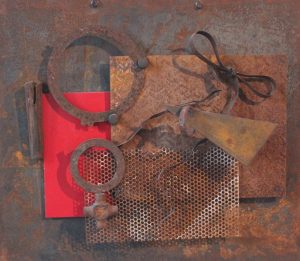 occurring in the wilderness or urban industrial areas. Toward this end, her sculptural expressions typically juxtapose wood, metal, photographs and electric light. Together, these elements metaphorically represent the synergy of earth, wind, fire and water in nature and all of life.
occurring in the wilderness or urban industrial areas. Toward this end, her sculptural expressions typically juxtapose wood, metal, photographs and electric light. Together, these elements metaphorically represent the synergy of earth, wind, fire and water in nature and all of life.
Patricia credits hiking in the woods in New Jersey and exploring the streets of New York City as a child with contributing 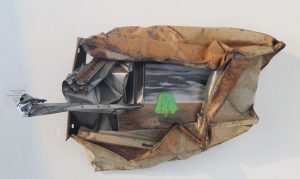 to the themes she expresses in her work. In fact, there’s something more primordial at play.
to the themes she expresses in her work. In fact, there’s something more primordial at play.
“Working with the abstract and with scrap metal comes from my soul and subconscious,” Esposito notes. “I call it spirit or my ancestors coming through, giving my art a voice.”
Recycled materials 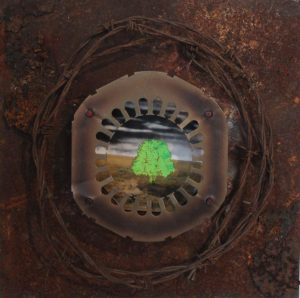 that reflect their past is an ongoing component of Patricia’s work.
that reflect their past is an ongoing component of Patricia’s work.
“Rust fascinates me,” she amplifies. “Metal goes through a metamorphosis, not unlike the colors and textures of the seasons. Corrosion of multiple layers, colors and textures can take years to achieve, resulting in the beautiful patina of an object’s current life. The contrast of earth and rust, with the harshness and coldness of steel, can live harmoniously as in some of my two and three dimensional works.”
It frequently takes 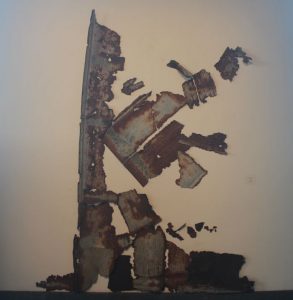 Esposito months, even years, to locate the proper scrap metal to complete a particular work of art. Patricia is currently engaging in expeditions through the Florida Everglades to uncover material for her ongoing exploration of natural decay.
Esposito months, even years, to locate the proper scrap metal to complete a particular work of art. Patricia is currently engaging in expeditions through the Florida Everglades to uncover material for her ongoing exploration of natural decay.
Esposito’s embrace of the material she utilizes imbues her with a cognizance of the impact human acts have on our environment. “The ongoing crisis of urbanization of what is left of our wilderness is always on my mind,” Patricia says resolutely.
“Some of my 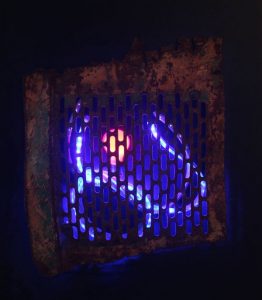 art pieces reflect my concerns about the environment and how it affects our life – as in my Tree Zero series and in my Water, Oppenheimer’s Tears, and Hiroshima art. The pitchforks are becoming harder and harder to find, as in my Politics piece. So are organic farms and farmers vanishing from our planet to make room for GMO’s (Geneticically Modified Organisms) in our food, the main cause for many diseases.”
art pieces reflect my concerns about the environment and how it affects our life – as in my Tree Zero series and in my Water, Oppenheimer’s Tears, and Hiroshima art. The pitchforks are becoming harder and harder to find, as in my Politics piece. So are organic farms and farmers vanishing from our planet to make room for GMO’s (Geneticically Modified Organisms) in our food, the main cause for many diseases.”
In this imperfect world, Esposito’s art can be seen as “perfectly imperfect.”
Patricia was one of 50 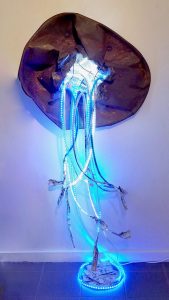 artists in 50 years of Photography at New York City’s Fashion Institute of Technology, a show celebrating its fiftieth anniversary. She also exhibited at Westbeth Gallery in NYC , Sona Gallery and Eros Gallery in Naples and the Sidney & Berne Davis Art Center, which featured her and fellow sculptor Jay Lana is a 2018 exhibit titled In Search for the Metal Muse: Juxtapositions in Disarray.
artists in 50 years of Photography at New York City’s Fashion Institute of Technology, a show celebrating its fiftieth anniversary. She also exhibited at Westbeth Gallery in NYC , Sona Gallery and Eros Gallery in Naples and the Sidney & Berne Davis Art Center, which featured her and fellow sculptor Jay Lana is a 2018 exhibit titled In Search for the Metal Muse: Juxtapositions in Disarray.
May 12, 2019.
________________
RELATED STORIES.
Esposito’s ‘Oppenheimer’s Tears’ an installation capable of fascinatingly disparate interpretations (05-14-18)
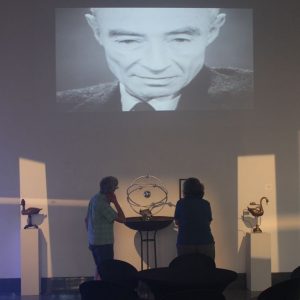 On view now through May 22 in the grand atrium of the Sidney & Berne Davis Art Center is an two-artist exhibit titled In Search of the Metal Muse: Juxtapositions in Disarray. The show features three-dimensional work by Jay Lana and Patricia Esposito that deal with issues of urbanization, war, and the environment. One is an installation titled Oppenheimer’s Tears, and it is particularly salient given the United States’ recent abrogation of the Joint Comprehensive Plan of Action a/k/a the Iran nuclear deal and the start of a summit between President Donald Trump
On view now through May 22 in the grand atrium of the Sidney & Berne Davis Art Center is an two-artist exhibit titled In Search of the Metal Muse: Juxtapositions in Disarray. The show features three-dimensional work by Jay Lana and Patricia Esposito that deal with issues of urbanization, war, and the environment. One is an installation titled Oppenheimer’s Tears, and it is particularly salient given the United States’ recent abrogation of the Joint Comprehensive Plan of Action a/k/a the Iran nuclear deal and the start of a summit between President Donald Trump 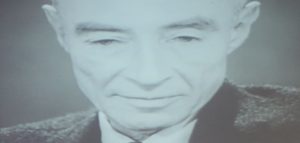 and Kim Jong Un in Singapore on June 12.
and Kim Jong Un in Singapore on June 12.
Robert Oppenheimer is remembered as the father of the atomic bomb. He gained that appellation as wartime head of the Los Alamos Laboratory and the director of science 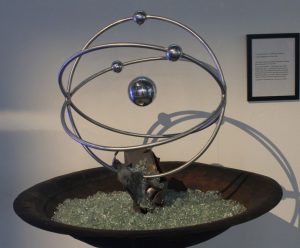 of the Manhattan Project. In these capacities, he was present when mankind detonated the first nuclear weapon near in the valley of the Journey of the Dead Man near Alamogordo, New Mexico at 5:30 on the morning of July 16, 1945.
of the Manhattan Project. In these capacities, he was present when mankind detonated the first nuclear weapon near in the valley of the Journey of the Dead Man near Alamogordo, New Mexico at 5:30 on the morning of July 16, 1945.
“The whole country was lighted by a searing light with the intensity many times that of the midday sun,” Manhattan Project Deputy Commander General Thomas Farrell 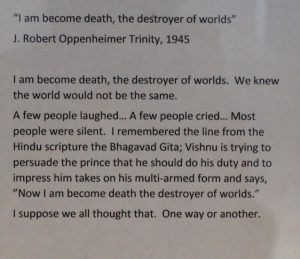 immediately following the blast. “It was golden, purple, violet, gray, and blue. It lighted every peak, crevasse, and ridge of the nearby mountain range with a clarity and beauty that cannot be described but must be seen to be imagined. It was that beauty the great poets dream about but describe most poorly and inadequately.”
immediately following the blast. “It was golden, purple, violet, gray, and blue. It lighted every peak, crevasse, and ridge of the nearby mountain range with a clarity and beauty that cannot be described but must be seen to be imagined. It was that beauty the great poets dream about but describe most poorly and inadequately.”
Harvard University President James Conant was less eloquent but more chilling. “The whole sky [was] suddenly full of white 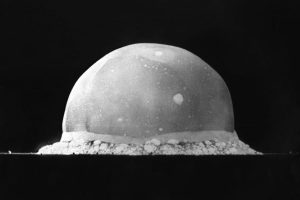 light like the end of the world,” he wrote after viewing the detonation from a V.I.P. viewing area about ten miles from the tower that housed “the gadget.”
light like the end of the world,” he wrote after viewing the detonation from a V.I.P. viewing area about ten miles from the tower that housed “the gadget.”
“We knew the world would not be the same,” Oppenheimer would say later. “A few people laughed, a few people cried, most were silent.”
But 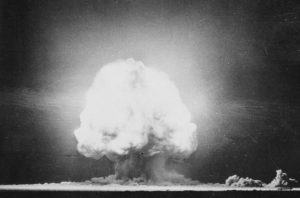 Oppenheimer himself had a rather strange reaction as he eyed the fireball emanating from the Trinity nuclear test. He mentally recited a line from the Bhagavad-Gita as he let the import of the moment sink in: “Now I am become Death, the destroyer of worlds.”
Oppenheimer himself had a rather strange reaction as he eyed the fireball emanating from the Trinity nuclear test. He mentally recited a line from the Bhagavad-Gita as he let the import of the moment sink in: “Now I am become Death, the destroyer of worlds.”
It is Krishna, the incarnation of Vishnu who speaks this line. 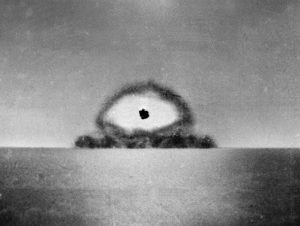 Vishnu is part of the Hindu Trinity, along with Brahma (the creator) and Shiva (the destroyer). The phrase signifies that the Tridevi occupies different forms and functions, and that the creator will also destroy the object of his creation at the appropriate moment in time.
Vishnu is part of the Hindu Trinity, along with Brahma (the creator) and Shiva (the destroyer). The phrase signifies that the Tridevi occupies different forms and functions, and that the creator will also destroy the object of his creation at the appropriate moment in time.
Krishna speaks the line to a soldier by the name of Arjuna who is conflicted about destroying an opposing army that includes 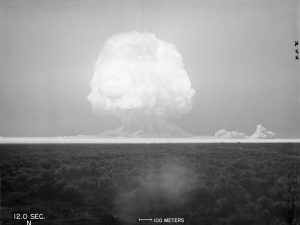 many of his own family and friends. In essence, Krishna tells Arjuna not to worry about who lives and dies; as a soldier, his only concern is to carry out his holy duty.
many of his own family and friends. In essence, Krishna tells Arjuna not to worry about who lives and dies; as a soldier, his only concern is to carry out his holy duty.
Stated somewhat differently, duty is to be undertaken in life for duty’s sake, without regard or attachment to any potential outcome, and this is apparently how Oppenheimer reconciled his role in developing a 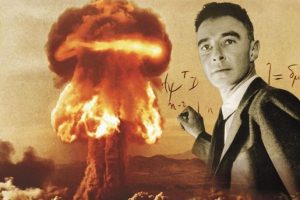 weapon that could one day lead to mankind’s complete and utter destruction. As a warrior-scientist, Oppenheimer identified with Arjuna. And while like Arjuna, he may have felt awe and trepidation in the face of the spectacle of death that he had unleashed that fateful morning in 1945 outside of Alamogordo, New Mexico, he was nonetheless justified by his blind devotion to duty.
weapon that could one day lead to mankind’s complete and utter destruction. As a warrior-scientist, Oppenheimer identified with Arjuna. And while like Arjuna, he may have felt awe and trepidation in the face of the spectacle of death that he had unleashed that fateful morning in 1945 outside of Alamogordo, New Mexico, he was nonetheless justified by his blind devotion to duty.
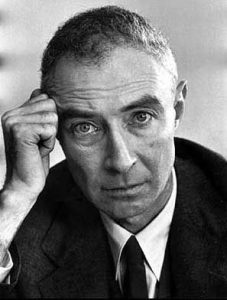 While she quotes Oppenheimer’s reference to the Bhagavad-Gita in her installation Oppenheimer’s Tears, Esposito avoids offering an opinion on the significance of the quotation.
While she quotes Oppenheimer’s reference to the Bhagavad-Gita in her installation Oppenheimer’s Tears, Esposito avoids offering an opinion on the significance of the quotation.
Is it her intention to suggest that Oppenheimer later regretted (shed tears) over the loss of life his device occasioned at Hiroshima and Nagasaki and mankind’s ensuing loss of innocence in the decades following as world leaders continue to threaten to annihilate each other and the planet with increasingly stronger nuclear weaponry?
Is it Esposito’s intent to draw attention to man’s ability to justify rote and wanton destruction as a moral 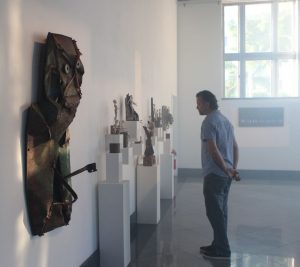 imperative sanctioned not only by the religious world view of Hinduism or Islam, but Western thought (here, reference is made to the argument advanced by philosophers and theologians that actions are moral only when performed as “duty for duty’s sake” as postulated by Immanuel Kant in his 1785 polemic Groundwork of the Metaphysics of Morals)?
imperative sanctioned not only by the religious world view of Hinduism or Islam, but Western thought (here, reference is made to the argument advanced by philosophers and theologians that actions are moral only when performed as “duty for duty’s sake” as postulated by Immanuel Kant in his 1785 polemic Groundwork of the Metaphysics of Morals)?
Or is Esposito’s installation to be regarded by viewers as an 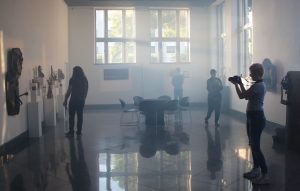 invitation to call into question the continuing morality of devotion to duty regardless of the consequences to man, to life as we know it, and to the viability of our planet?
invitation to call into question the continuing morality of devotion to duty regardless of the consequences to man, to life as we know it, and to the viability of our planet?
Draw your own conclusions when you view Oppenheimer’s Tears and Esposito’s other thought-provoking sculptural works. But as you eye the  stainless steel atom beneath the forlorn projected gaze of the father of the atom bomb, notice the crystalline glass in the wooden bowl beneath the atom. It shows that the artist really did her homework in conceiving and creating the art piece.
stainless steel atom beneath the forlorn projected gaze of the father of the atom bomb, notice the crystalline glass in the wooden bowl beneath the atom. It shows that the artist really did her homework in conceiving and creating the art piece.
Because the gadget exploded so close to the ground, dirt and debris was sucked into the resulting fireball. Some of it melted and settled back down, cooling into a radioactive green glass that was dubbed Trinitite. And Esposito’s crystals are appropriately light green, evidencing the raw power of  a nuclear blast to convert the soil that gives life to plants and animals into inert but seductively alluring radioactive matter incapable of supporting life.
a nuclear blast to convert the soil that gives life to plants and animals into inert but seductively alluring radioactive matter incapable of supporting life.
The Sidney & Berne Davis Art Center is located at 2301 First Street in the heart of the downtown Fort Myers River District. For more information, please telephone 239-333-1933 or visit http://www.sbdac.com.













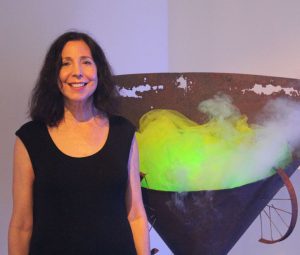

 Tom Hall is both an amateur artist and aspiring novelist who writes art quest thrillers. He is in the final stages of completing his debut novel titled "Art Detective," a story that fictionalizes the discovery of the fabled billion-dollar Impressionist collection of Parisian art dealer Josse Bernheim-Jeune, thought by many to have perished during World War II when the collection's hiding place, Castle de Rastignac in southern France, was destroyed by the Wehrmacht in reprisal for attacks made by members of the Resistance operating in the area. A former tax attorney, Tom holds a bachelor's degree as well as both a juris doctorate and masters of laws in taxation from the University of Florida. Tom lives in Estero, Florida with his fiancee, Connie, and their four cats.
Tom Hall is both an amateur artist and aspiring novelist who writes art quest thrillers. He is in the final stages of completing his debut novel titled "Art Detective," a story that fictionalizes the discovery of the fabled billion-dollar Impressionist collection of Parisian art dealer Josse Bernheim-Jeune, thought by many to have perished during World War II when the collection's hiding place, Castle de Rastignac in southern France, was destroyed by the Wehrmacht in reprisal for attacks made by members of the Resistance operating in the area. A former tax attorney, Tom holds a bachelor's degree as well as both a juris doctorate and masters of laws in taxation from the University of Florida. Tom lives in Estero, Florida with his fiancee, Connie, and their four cats.